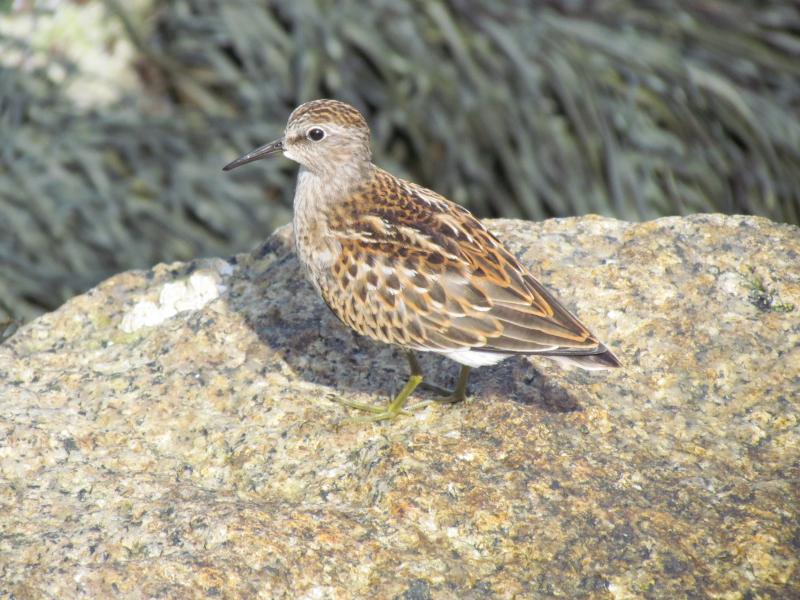Sending the Bird “Kids” Off to “College”
It always seems to come so suddenly. One morning you step outside and gone is the oppressive humid 80-degree heat, replaced by dry, crisp 60-degree air. The air conditioner is no longer a necessity for sleep at night. More and more often the wind seems to blow from the north.
Summer is not completely gone. The occasional hot day pops up and begs the question as to whether a swim in the lake is possible even though the water has cooled considerably so that it feels bracing rather than like stepping into a warm bath as it did in early August.
For us, like many others, that end-of-summer melancholy is forever linked to the anxiety and excitement of starting a new season of school. When a child heads off to college, all those feelings are compounded into what has been called the “empty nest syndrome.”
We ourselves are experiencing that situation as our son heads off to college for the first time. The ornithological reference to the “empty nest” is an amusing irony that is not lost on us! So to keep our minds occupied, we started thinking about what the equivalent would be in the bird world to sending your kid off to college.
A large majority of the birds that we are familiar with as both breeders and migrants here in Maine raise their young incredibly quickly. Many songbirds incubate their eggs for a couple of weeks, raise the young in the nest for a couple more weeks, and then may continue to feed them after they can fly, for another week or so. After those few weeks, the young are on their own. In some species the female may begin laying eggs and incubating again while the male is feeding the almost fully independent youngsters from the first brood. When the second brood hatches (or sometimes even before), the male leaves the offspring from the first brood to fend for themselves.
In plovers and sandpipers, the eggs are incubated longer—often around three weeks or so—and the young hatch with a coat of down and the ability to walk and feed themselves. The adults still stay with them, protect them and show them the ropes for a few weeks, but it is not long after this that the adults leave to begin the long southward journey to the wintering grounds. The young birds are left on their own at that point, with weeks to go before they are fully matured and ready to migrate.
Leaving the young to strike out on their own for a journey thousands of miles long through landscapes that they have never seen, with untold perils before them, seems like the bird version of sending one’s son or daughter off to college.
How a bird hatched and raised this summer, perhaps in the Arctic or right here in Maine, could be able to follow its inner drive to fly south night after night, sometimes flying for days over open ocean, until it reaches Mexico or Central America or the Caribbean or South America, is almost beyond human comprehension. But birds do it, and those that make it to the wintering grounds and back north the following spring could be said to have received their college diploma—multiple years, and they’ve pretty much got their Ph.D. in bird survival.
For the new college student, a comfortable bed, decent food at the dining hall, and a good roommate can make all the difference. For a young bird on its first migration, healthy habitats with food and places to sleep and hide from predators will be essential for it to survive its “course work” and make it to the wintering grounds. Protecting and restoring habitats across the flyways for these birds is essential, which is why supporting groups like the Boothbay Region Land Trust is so important. And why maintaining native plants and healthy habitat in our backyards and gardens can also help.
Even if you yourself are not sending off a child or grandchild to college this fall, maybe you can think of all of the young migrating birds flitting through your backyard and skittering across beaches and wetlands as your “college bound” bird “kids” and do what you can to give them their best chance of success.
Jeffrey V. Wells, Ph.D., is a Fellow of the Cornell Lab of Ornithology and Vice President of Boreal Conservation for National Audubon. Dr. Wells is one of the nation's leading bird experts and conservation biologists and author of the “Birder’s Conservation Handbook.” His grandfather, the late John Chase, was a columnist for the Boothbay Register for many years. Allison Childs Wells, formerly of the Cornell Lab of Ornithology, is a senior director at the Natural Resources Council of Maine, a nonprofit membership organization working statewide to protect the nature of Maine. Both are widely published natural history writers and are the authors of the popular book, “Maine’s Favorite Birds” (Tilbury House) and “Birds of Aruba, Bonaire, and Curaçao: A Site and Field Guide,” (Cornell University Press).





























